In this article, we’ve got all the information you need to decide on the optimal kayak size. Discuss kayak sizes like a pro!
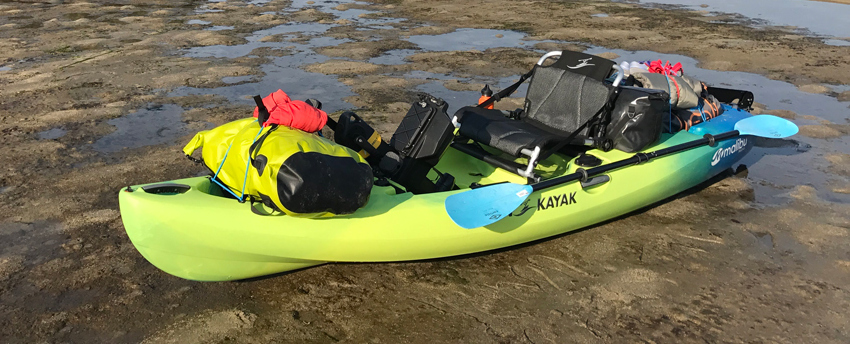
Picking the right kayak for your weight is really important to keep you safe on the water and to help you get the most out of your paddling.
Selecting your perfect kayak is not easy. Many people get bogged down in the features of a kayak and ignore the specifications. However, these specifications are the make-or-break factors for you selecting the right kayak.
One specification which is often overlooked is the kayak’s weight limit. Every kayak comes with its own weight limit, or capacity. Often similar-looking kayaks have different capacities.
This article will look into finding the right size kayak for your weight.
As an affiliate of Amazon and other retailers, we may earn a small commission when you buy via our links, at no additional cost to you. Thank you!
What is a Kayak’s Weight Limit?
The weight limit of a kayak is, in short, the most weight you can put in the kayak before it sinks.
Think about it as a safety limit.
As we explain below, there’s a difference between this maximum capacity and performance weight limit.
Also, remember that the total weight includes everything: you, your clothing, your PFD, your paddle, and any other equipment you take with you.
These might all be lightweight, but the combined weight of those may surprise you. Don’t just think about your body weight.
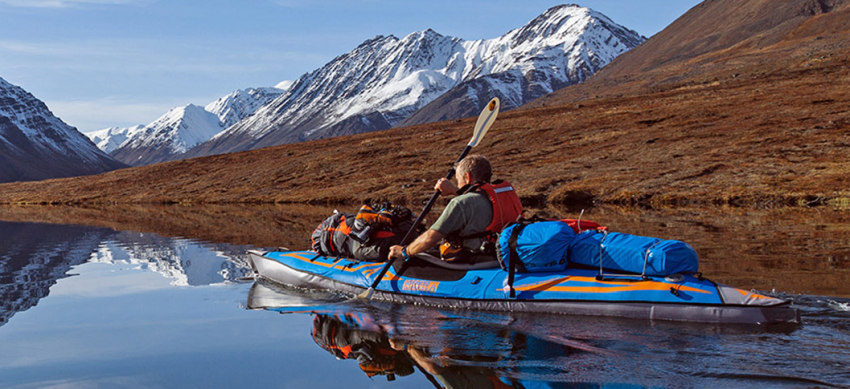
How do Manufacturers Determine the Weight Rating of Their Kayaks?
There are no industry rules for determining the weight limit of kayaks, which can lead to some confusion.
Different manufacturers use different techniques to find out how much weight their boats can hold.
Some will add weights to the boat until it sinks below the waterline, or is deemed unpaddleable.
Others will take the boat out in a range of environments and test performance with a variety of weights aboard.
Some rely on CAD design to estimate how much volume a kayak needs to have below the waterline in order to support the required weight.
To make matters even more confusing, some even include the weight of the assembled kayak itself in the total capacity.
With boats varying so much, from design to intended use, there’s no standard way for defining the maximum capacity. You can be sure, though, that boat designers have gone through rigorous testing to make sure you get the most out of your kayak.
What Affects a Kayak’s Capacity?
The main three factors that affect a kayak’s weight limit are length, width, and volume.
Width
Let’s start with width. This is the one that always seems obvious to people. The wider the kayak, the higher the weight limit. Another benefit to width is stability. A wider kayak will be more stable, so less likely to tip if it’s got a lot of weight in it.
Length
Length affects a lot of characteristics of the kayak, including speed, tracking, and weight limit. The longer a boat, the more stable it is going to be in the water and the more weight it can take.
Volume
Length and width are elements of volume. Volume is determined by the width, length, and hull shape of the kayak. A higher volume kayak has more inherent buoyancy. More buoyancy means it can take more weight without sinking.
Maximum Capacity vs. Performance Capacity: The 70% Rule
So, there is a difference between a kayak’s maximum capacity and its performance capacity.
While the maximum capacity is more like a safety indicator, the performance weight limit is what you should be looking at when choosing a kayak.
Most companies don’t state the performance capacity of their kayaks. But the rule of thumb is that for optimal performance, you should not load your kayak to more than 70% of its maximum weight limit.
Therefore, if your kayak has a maximum weight limit of 500 lbs., it will perform well with up to about (500*0.7) = 350 lbs. of weight.
Here’s a table with the optimal performance capacity for different maximum weight limits:
| Maximum Weight Limit | Performance Weight Limit |
| 200 lb (91 kg) | 140 lb (64 kg) |
| 250 lb (113 kg) | 175 lb (79 kg) |
| 300 lb (136 kg) | 210 lb (95 kg) |
| 350 lb (159 kg) | 245 lb (111 kg) |
| 400 lb (181 kg) | 280 lb (127 kg) |
| 450 lb (204 kg) | 315 lb (143 kg) |
| 500 lb (227 kg) | 350 lb (159 kg) |
| 550 lb (249 kg) | 385 lb (175 kg) |
| 600 lb (272 kg) | 420 lb (191 kg) |
What Load Capacity to Look for When Buying a Kayak
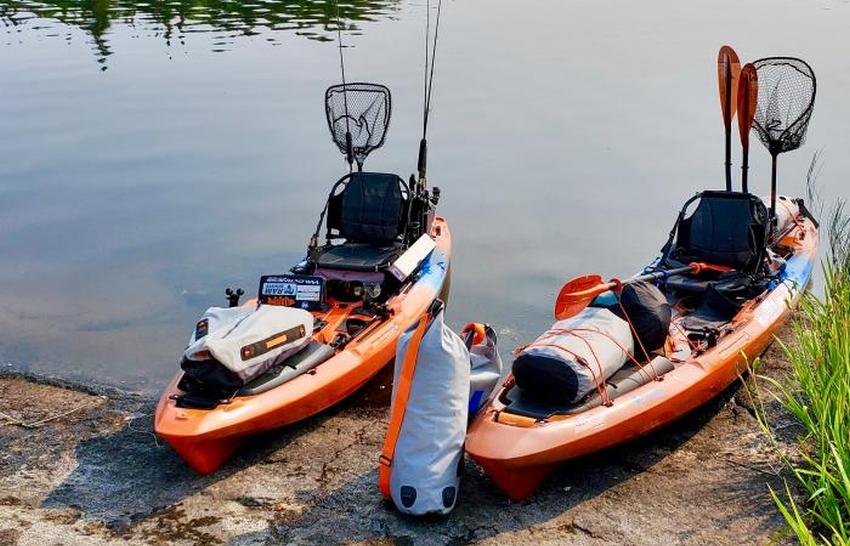
Now that you know how to determine the performance weight limit you need in a kayak, how do you actually find the right kayak for your weight?
Here’s another table to help you.
To estimate the total weight you need to use in your calculations, we’ve included three gear scenarios.
There’s a lightweight scenario when you go out in summer clothes (5 lbs) with only a life jacket (2 lbs), a paddle (2 lbs), and a bottle of water (1 lb), which gives you an extra 10 lbs of gear.
Then there’s a heavy load scenario that includes 50 lbs of fishing or camping gear. That’s a conservative estimate.
And finally, there’s an extreme scenario with 100 lbs of motors, batteries, fishfinders, coolers, anchors, and tackle. Actually, we’ve seen some kayak anglers going even heavier than that!
We divided the total weight by 0.7 to get the maximum weight limit we’re looking for.
| Paddler weight, lb | Kayak’s Maximum Capacity | |||
| 10 lbs extra gear | 50 lbs extra gear | 100 lbs extra gear | ||
| 100 | 157 | 214 | 286 | |
| 125 | 193 | 250 | 321 | |
| 150 | 229 | 286 | 357 | |
| 175 | 264 | 321 | 393 | |
| 200 | 300 | 357 | 429 | |
| 225 | 336 | 393 | 464 | |
| 250 | 371 | 429 | 500 | |
| 275 | 407 | 464 | 536 | |
| 300 | 443 | 500 | 571 | |
| 325 | 479 | 536 | 607 | |
| 350 | 514 | 571 | 643 | |
| 375 | 550 | 607 | 679 | |
NOTE: If you’re close to the top end, or even pushing toward the 70% limit, it’s worth considering a larger model. This will give you more choices for winter clothing and any equipment you want to carry.
What are Average Kayak Weight Limits?
Here are some examples of kayaks with different capacities. This should give you an idea of what kayak you need for your weight.
Kids’ Kayaks
Kayaks for kids start at about 100 lb capacity. Some models can carry up to 275 lb and are also suitable for small adults.
| Kayak Model | Maximum Weight Limit |
| Pelican Solo | 100 lb (45.4 kg) |
| Old Town Heron Junior | 115 lb (52.2 kg) |
| Perception Prodigy XS | 150 lb (68 kg) |
| Eddyline Sky 10 | 250 lb (113.4 kg) |
| Perception Joyride 10 | 275 lb (125 kg) |
RELATED: 8 Best Kayaks for Kids
Recreational Kayaks
Recreational kayaks can typically carry anywhere from 250 lb to about 450 lb.
| Kayak Model | Maximum Weight Limit |
| Pelican Argo 100x | 275 lb (125 kg) |
| Perception Drift 9.5 | 300 lb (136 kg) |
| Perception Carolina 14 | 300 lb (136 kg) |
| Wilderness Systems Pungo 120 | 325 lb (147 kg) |
| Wilderness Systems Tsunami 140 | 325 lb (147 kg) |
| Old Town Loon 120 | 375 lbs (170 kg) |
| Wilderness Systems Pungo 125 | 425 lbs (193 kg) |
Fishing Kayaks
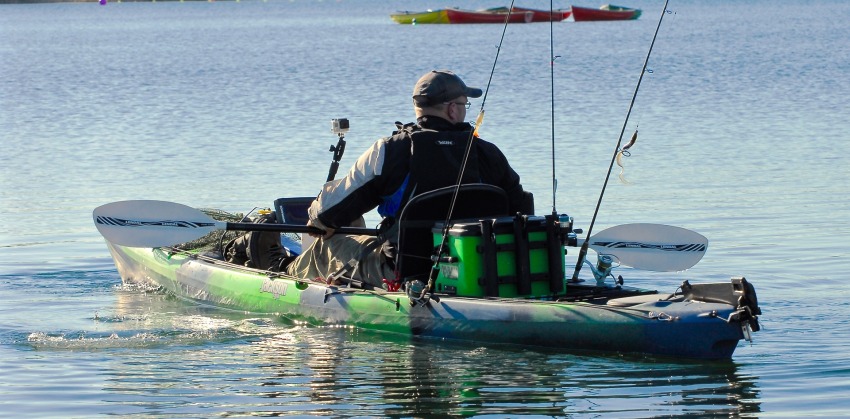
Fishing kayaks vary in capacity. Some lightweight, throw-and-go boats are rated at 300 lb, while large kayaks made for offshore fishing can carry up to 650 lb or more.
Recreational kayaks can typically carry anywhere from 250 lb to about 450 lb.
| Kayak Model | Maximum Weight Limit |
| Lifetime Tamarack Angler | 275 lb (125 kg) |
| Vibe Skipjack 90 | 300 lb (136 kg) |
| Perception Outlaw 11.5 | 425 lbs (193 kg) |
| Vibe Sea Ghost 130 | 550 lbs (249.5 kg) |
| Hobie Mirage Pro Angler 14 | 600 lb (272 kg) |
| NuCanoe Unlimited | 650 lb (294 kg) |
RELATED: Best Kayaks for Big Guys
Tandem Kayaks
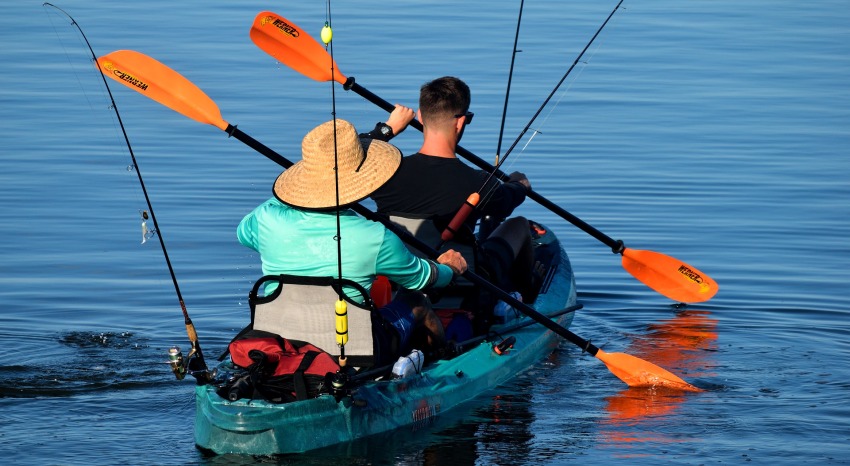
Two-person kayaks can have a weight limit of 400 to over 600 lb. Remember that boats with more capacity are usually longer and heavier, so think about how you’re going to transport and store your kayak.
| Kayak Model | Maximum Weight Limit |
| Ocean Kayak Malibu Two | 425 lb (192.8 kg) |
| Pelican Argo 136X Tandem | 500 lb (227 kg) |
| Wilderness Systems Pamlico 145T | 500 lb (227 kg) |
| Crescent Crew | 600 lb (272 kg) |
| Sea Eagle 385ft | 635 lb (288 kg) |
RELATED: Best Tandem Kayaks: Reviews and Buying Guide
What Happens if You Exceed Your Kayak’s Capacity?
Now that we know what the limit of our kayak means, is it really that bad if we exceed it?
If you exceed the optimal weight or performance weight of your kayak, then your kayak will not perform how it was intended.
- Your kayak will sit lower in the water than it was designed to.
- It will be slower and harder to turn than intended.
- With all the extra weight, the kayak becomes less stable and easier to tip.
An overloaded kayak is also much less maneuverable and more likely to pick its own course. When the bow of a kayak buries itself into the water, it will likely veer to one side and become very difficult to correct. This is especially problematic on rivers and in the sea.
Remember, your kayak should be loaded in a balanced way. If you load all of your gear into one side of the kayak, or all at the bow, or stern, you may find your kayak more difficult to handle. Check out our article on packing your kayak for more information on this.
But what if we start to exceed the maximum weight limit? This is when you will start to sit dangerously low in the water and even if you don’t capsize, you’ll be taking on water and at risk of sinking. Your boat will be moving incredibly slowly and creating a noticeable bow wave off the front.
In this video, KBS’s Chad Hoover demonstrates how a kayak behaves when overloaded:
Both sit-on-top and sit-in kayaks react slightly differently to this, so we’ll explore both separately in the next section.
Sit-on-top vs Sit-inside Kayaks: Weight Limit Considerations
As with everything in kayaking, there’s a slight difference between sit-on-top and sit-in kayaks when it comes to weight limits.
Let’s start with sit-on-top kayaks. These kayaks are often wider and more stable than their sit-in counterparts. They’re usually far easier to climb on and off, not having to slide yourself gracefully into a cockpit while trying to remain balanced.
All of this is great, but it doesn’t mean that they have a higher weight limit than a sit-in kayak.
It’s often easier to accidentally overload a sit-on-top kayak, simply because they look far more stable. The slightly daunting thought of capsizing a sit-in kayak often puts us off getting anywhere near the point we feel unstable. Also, because we aren’t relying on internal hatch storage, we can find ourselves piling equipment high on a sit-on-top.
With these boats being wider and relatively low, you might not notice the instability as much on a sit-on-top, but you’ll definitely notice how much you slow down. You’ll also notice how much more hard work it is just to paddle your kayak about.
If you overload a sit-on-top, it’s not always quite as disastrous as it can be with a sit-in, but as always it depends on the situation. Firstly, if you’re sitting too low, you can take water over the top of your boat and get a really wet, unstable ride.
Sit-on-top kayaks often rely on scupper holes to drain the water out of the boat in calm conditions. If your kayak is overloaded, these won’t be draining effectively and you may even see water rising through them. You can plug these, but if you’re that low in the water, you’d be better off shedding some weight from your ride.
Sit-in kayaks can often be far more problematic if we overload them. The first thing to consider here is that if you yourself are close to the weight limit, without any equipment, then the boat will probably feel tight. If the boat is too tight, you’ll struggle to get out of it in the event of a capsize.
An overloaded sit-in kayak will sit low in the water and have all the performance issues we looked at earlier. If you’re sitting too low in the water, any slight ripples or waves can send water pouring into your boat. Once this starts, it’s very difficult to prevent.
A sit-in kayak has loads of space inside it and if all of this fills up, you’ll quickly start to sink. Most sit-in kayaks are either fitted with bulkheads or can have float bags added to prevent this.
Bulkheads are more commonly seen on touring or sea kayaks and often separate the storage areas from the cockpit. These sealed barriers completely prevent water from flooding the various areas of the boat and make a rescue possible in the event of a capsize.
Float bags work similarly and are more commonly seen in white water or recreational kayaks. These sealed, inflated bags fill the space behind the seat, and sometimes in front of the footrest, and create air pockets that water cannot fill. This stops the boat from sinking if water comes in.
Bulkheads and float bags help a little, but they’re not a solution to overloading a boat. There are ways to rescue a swamped kayak, including bailing with a bilge pump or bucket and these are important rescue techniques for any paddler heading out from shore.
Is it possible to increase the weight limit of a kayak?
In short, no.
There’s a lot of tricks people have tried along the way to increase the weight limit, but ultimately the only solution is to get a bigger boat.
A lot of people think float bags increase the weight limit. These bags simply take up space and stop water from filling a cavity. The whole time your kayak is above water, these bags of air are taking the place of the air that would be there anyway. They don’t increase the volume of the boat and therefore the weight limit does not change.
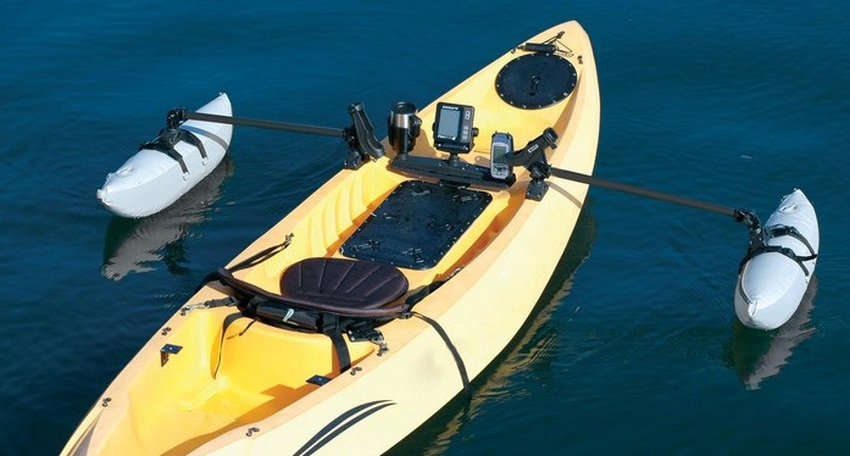
Outriggers are another popular choice. These do make the kayak more stable which can make it easier to paddle an overloaded boat, but they don’t change the limit. You’ll still encounter all the same speed, handling, and potential safety issues as you would anyway, it might just feel more stable.
FAQ
Yes. There are kayaks available for paddlers of all shapes and sizes, just remember to keep within the 70% rule.
No one is going to show up on a lake and enforce the weight limits, but they are important. These limits keep you safe on the water and ensure that your kayak performs as it was designed to.
We don’t advise that you go over the weight limit on your kayak. Staying at under 70% of capacity will keep your kayak above water and paddling efficiently. Over 70% and you will start to notice performance issues. If you get close to the maximum capacity you can start to take on water and this can be dangerous.
Usually, sit-on-top kayaks have higher weight limits than sit-in kayaks. Fishing kayaks, designed for carrying specialist equipment, are often a good choice for high-capacity kayaks too. Two-person kayaks can often be adapted for a solo paddler and these often have capacities in excess of 500 lbs.
Two-person kayaks vary as much as solo kayaks. These boats all have different uses and intended paddlers and it’s important to do as much research for a tandem boat as you would with a solo kayak.









